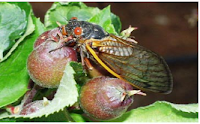Some counties in Virginia have several broods that impact all or part of the county. The 2004 emergence impacted Loudoun, Prince William, Fairfax and Fauquier all of which will be impacted by the Magicicada Brood II that is emerging this year. The 17 year periodical cicadas or Magicicada adults have black bodies, red eyes and orange wing veins, with a black "W" near the tips of the forewings. The annual Cicada or dog day cicada as it is also called are related to the periodical cicada and appear every summer during the long, hot dog days of July and August. These cicadas have two- to five-year life cycles, but their broods overlap and some appear every summer. That is not the Cicadas that are now emerging from the ground.
 |
| 17 Year Periodical Cicadas |
Right now mature nymphs are emerging from the soil and climbing onto nearby vegetation and other vertical surfaces. They then molt to the winged adult stage. The emergence is tightly synchronized, with most adults appearing within a few nights. Adult cicadas live for only two to four weeks. When the 17 year periodical cicadas emerge the density can be shocking and noisy. It is common to have tens to hundreds of thousands of periodical cicadas per acre, but there are records of up to a million and a half periodical cicadas. This is far beyond the density of most other cicada species and half of the cicadas are “singing.” Male cicadas sing quite loudly by vibrating membranes on the sides of their abdominal segment. Male songs and choruses are a courtship ritual to attract females for mating. The males’ choruses have been known to drive people to distraction-stay inside with the windows closed and if need be use a fan for white noise. After mating, females lay their eggs in narrow young twigs slicing into the wood and depositing up to 400 eggs in total for each female in 40 to 50 locations each.
It is the egg laying that does most of the damage associated with periodical cicadas. Cicada eggs remain in the twigs for six to ten weeks before hatching. The nymphs do not feed on the twigs. The newly hatched, ant-like nymphs fall to the ground where they burrow 6 to 18 inches underground to feed on roots. Mature trees and shrubs usually survive even dense emergences of cicadas without long term damage, but in the summer of a large emergence many deciduous trees turn brown due to the breakage and death of peripheral twigs caused by the females laying their eggs and the emergence of the nymphs. Nonetheless, only young trees are usually permanently damaged and that is because so much of these trees are small twigs and branches. Newly planted trees need to be protected from periodical cicadas. Newly planted trees can be covered with a fine netting to keep the cicadas from reaching the small tender twigs. Secure the netting around the trunk to stop them from climbing up into the tree.Fruit trees need to be protected from the cicadas if they are to fruit this year.
Apparently because of their long life cycles and the synchronization of their emergence, periodical cicadas do not have natural population control by predators, even though everything from birds to spiders to snakes to dogs eats them opportunistically when they do appear. The massive emergence is believed to overwhelm predators and most of the periodical cicadas survive to mate and reproduce. Which is the whole point of the emergence. Cicadas are not poisonous and do not have a stinger. Their survival and expansion strategy is based purely on numbers.
It is the egg laying that does most of the damage associated with periodical cicadas. Cicada eggs remain in the twigs for six to ten weeks before hatching. The nymphs do not feed on the twigs. The newly hatched, ant-like nymphs fall to the ground where they burrow 6 to 18 inches underground to feed on roots. Mature trees and shrubs usually survive even dense emergences of cicadas without long term damage, but in the summer of a large emergence many deciduous trees turn brown due to the breakage and death of peripheral twigs caused by the females laying their eggs and the emergence of the nymphs. Nonetheless, only young trees are usually permanently damaged and that is because so much of these trees are small twigs and branches. Newly planted trees need to be protected from periodical cicadas. Newly planted trees can be covered with a fine netting to keep the cicadas from reaching the small tender twigs. Secure the netting around the trunk to stop them from climbing up into the tree.Fruit trees need to be protected from the cicadas if they are to fruit this year.
Apparently because of their long life cycles and the synchronization of their emergence, periodical cicadas do not have natural population control by predators, even though everything from birds to spiders to snakes to dogs eats them opportunistically when they do appear. The massive emergence is believed to overwhelm predators and most of the periodical cicadas survive to mate and reproduce. Which is the whole point of the emergence. Cicadas are not poisonous and do not have a stinger. Their survival and expansion strategy is based purely on numbers.
 |
| The brown tips are the damage from Cicadas |

No comments:
Post a Comment